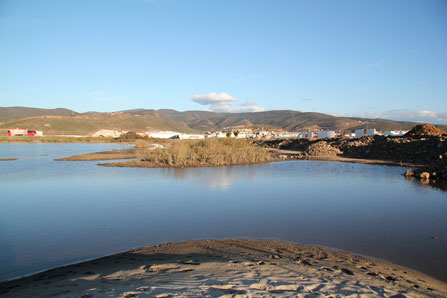Threatened by desalinization plant, citizens demand: "Let Lagunita del Ciprés live"

The public requests official protection for this beach to the south of Ensenada (Photo: courtesy of bionero.org).
MEXICALI
Ensenada activists and local citizens appeared at the office of Francisco Vega, governor of Baja California to ask him to declare Lagunita del Ciprés, on the coast of Ensenada, a protected natural area.
Hundreds of Ensenada residents have united to demand protection of this body of fresh water, located in the vicinity of the housing tract Infonavit Punta Banda and El Ciprés Beach to the south of the city of Ensenada.
It is the last remaining coastal lagoon along Todos los Santos Bay and is threatened by the desalinization plant project that former mayor Enrique Pelayo is trying to push through.
On Jan. 30, members of two groups, Haciendo lo Necesario, y Arte y Medio Ambiente en Armonía (literally: “Doing what’s Necessary” and “Art and the Environment in Harmony”) presented the show “Lagunita el Ciprés, Let It Live” along with a photography exhibition in the central plaza of the governor’s office in Mexicali. Their message was clear: The desalinization plant would mean the desiccation of the lagoon and a permanent change to habitat that is refuge to thousands of migratory birds.
In attendance was José Luís García Chavira, representative of the state’s Secretariat of Environmental Protection, who promised to follow up on the proposal to declare the lagoon a protected natural park.
Environmentalist Rita Beadle Luna said they will also ask the state Congress to request the governor accelerate protection of the site.
History and Public Management
The diary of the Juan Rodríguez Cabrillo expedition (1542) describes the large freshwater lakes of the bay known as Ensenada de Todos los Santos as a source of life for a large city. Population growth has shrunk these large lagoons, doing away with most of this natural source of water.
Today, Lagunita del Ciprés is the only wetland in the area that has survived the intense and frequent threats.
For a body of fresh water right next to the ocean, it has a unique system comprised of a basin, lagoon, dunes and beach. The combination is one of the city's most valuable natural areas and worthy of conservation.
For many years people have used it as a recreational area.
The system provides environmental benefits, such as protecting the city from flooding during winter storms and retaining rainwater. It also benefits wildlife biodiversity because it is a nesting site, as well as a resting and feeding area for local and migratory birds.
Due to its great importance, the Urban Development Program of Ensenada’s Population Center considers this a conservation zone.
Citizens have been asking federal government authorities to designate the lagoon as a protected area since 2011.
In June 2013, the signatures of 4,000 Ensenada residents were submitted to David Korenfeld Federman, director general of the National Water Commission (Conagua), requesting that the declaration be made. A copy of the document was sent to President Enrique Peña Nieto, José G. Osuna Millán, governor of the state at the time, and to the former mayor of Ensenada, Enrique Pelayo Torres.
On March 15, 2013, with support from civil society, the Secretariat of Environmental Protection announced the initiation of the designation process in the state’s official newspaper.
